Las Vegas, Nevada Blood Testing Facilities
 Represents a LabCorp blood testing facility
Represents a LabCorp blood testing facility Represents a Quest Diagnostics blood testing facility
Represents a Quest Diagnostics blood testing facility
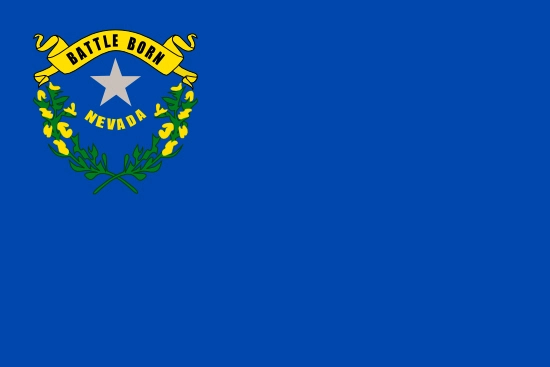
Nearby Labcorp Blood Testing facilities:
- Labcorp Center Distance: 2 m, 1815 E Lake Mead Blvd Ste 311, North Las Vegas, Clark County, NV, 89030
- Labcorp Center Distance: 3 m, 3440 W Cheyenne Ave A400, North Las Vegas, Clark County, NV, 89032
- Labcorp Center Distance: 4 m, 2080 E Flamingo Rd Ste 110, Las Vegas, Clark County, NV, 89119
- Labcorp Center Distance: 6 m, 2851 N Tenaya Way Ste 203, Las Vegas, Clark County, NV, 89128
- Labcorp Center Distance: 7 m, 5380 S Rainbow Blvd 208, Las Vegas, Clark County, NV, 89118
- Labcorp Center Distance: 9 m, 653 N Town Center Dr Ste 50, Las Vegas, Clark County, NV, 89144
- Labcorp Center Distance: 11 m, 9315 W Sunset Rd Ste 102, Las Vegas, Clark County, NV, 89148
- Labcorp Center Distance: 12 m, 129 W Lake Mead Pkwy Ste 1, Henderson, Clark County, NV, 89015
- Labcorp Center Distance: 47 m, 1420 E Calvada Blvd Ste 200, Pahrump, Nye County, NV, 89048
- Labcorp Center Distance: 80 m, 2580 Hwy 95 Ste 216, Bullhead City, Mohave County, AZ, 86442
- Labcorp Center Distance: 91 m, 2401 Stockton Hill Rd Ste 3, Kingman, Mohave County, AZ, 86401
Nearby Quest Blood Testing facilities:
- Quest Center Distance: 2 m, 1815 E Lake Mead Blvd, North Las Vegas, Clark County, NV, 89030-7188
- Quest Center Distance: 4 m, 305 N Nellis Blvd, Las Vegas, Clark County, NV, 89110-5493
- Quest Center Distance: 5 m, 761 S Rainbow Blvd, Las Vegas, Clark County, NV, 89145-6249
- Quest Center Distance: 6 m, 7460 W Lake Mead Blvd, Las Vegas, Clark County, NV, 89128-0296
- Quest Center Distance: 7 m, 6301 Mountain Vista St, Henderson, Clark County, NV, 89014-2365
- Quest Center Distance: 8 m, 6945 Aliante Pkwy, North Las Vegas, Clark County, NV, 89084-3198
- Quest Center Distance: 9 m, 7891 W Tropical Pkwy, Las Vegas, Clark County, NV, 89149-4548
- Quest Center Distance: 11 m, 10001 S Eastern Ave, Henderson, Clark County, NV, 89052-3908
- Quest Center Distance: 12 m, 210 N Boulder Hwy, Henderson, Clark County, NV, 89015-5302
- Quest Center Distance: 13 m, 2505 Anthem Village Dr, Henderson, Clark County, NV, 89052-5505
- Quest Center Distance: 47 m, 150 S Highway 160, Pahrump, Nye County, NV, 89048-2133
- Quest Center Distance: 81 m, 3003 Highway 95, Bullhead City, Mohave County, AZ, 86442-7896
Las Vegas Hormone Replacement Therapy Services
If you’ve been considering Hormone Treatments to amplify your health and wellness, you’ve come to the right place. The Conscious Evolution Institute is a Hormone Clinic which specializes in Hormone Optimization, and we are proud to serve the entire Las Vegas metropolitan area, as well as the entire state of Nevada. Our clinic has licensed and board certified medical affiliates located in your area that can perform the tests necessary to provide a clear and accurate picture of your health, and whether you can benefit as a patient from the Hormone Treatments we provide.
If your Comprehensive Hormone Panel indicates that you can benefit from Bio-Identical HRT Treatment or any other form of Hormone Therapy, we can deliver the Hormone Products and Services that can benefit you most straight to your address. If you are interested in Hormone Replacement Treatments like HGH or Testosterone, we encourage you to reach out to us via the phone number you see at the top of the page or by filling out the form on this page. We look forward to hearing from you!
Las Vegas Human Growth Hormone Therapy for HGH Deficiency and Hypopituitarism
If you’ve been paying any attention to the media in recent years, it’s likely that you’ve heard of Human Growth Hormone. HGH is one of the most vital hormones that is produced by the body, especially when it comes to preserving wellness and youthfulness. Human Growth Hormone is responsible for facilitating optimal cellular metabolism, meaning that it is responsible for speeding up the rate at which the cells of the body perform their vital processes. During our late teens and twenties, HGH Levels are such that the human body is optimized and functioning at its peak.
Beyond the age of 30, however, Human Growth Hormone Production starts to enter a state of chronic decline, which can become symptomatic over the course of many years or decades, depending upon the individual physiology and health state of the patient. HGH Injection Therapy is designed to restore Growth Hormone Levels to those which are experienced during young adulthood, in order to help patients feel and look younger. HGH is not an anti-aging therapy, but Bio-Identical HGH can help patients struggling with Human Growth Hormone Deficiency experience vastly improved health in the form of weight loss, healthier cholesterol levels, and improved mood and memory, just to name a few. HGH Therapy can be truly lifechanging for patients with a legitimate deficiency.
Las Vegas Sermorelin Acetate Therapy for Human Growth Hormone Deficiency
If you are interested in Bio-Identical HGH, Sermorelin Injection Therapy is another option that is on the table for needy patients. Sermorelin is a Recombinant Hormone Treatment which is designed to restore healthy and youthful HGH Production by encouraging the natural production of Human Growth Hormone by the pituitary gland. For patients experiencing Somatopause or Age-Related HGH Deficiency, the pituitary gland is usually healthy, and Growth Hormone Deficiency is caused by diminishing levels of Growth Hormone-Releasing Hormone by the hypothalamus. Sermorelin is a functional analog of GH-RH, and can get your HGH Levels back to normal! Sermorelin is available for off-label prescription, and is a more cost-effective alternative to HGH while providing the same great benefits, or even improved benefits for some patients!
Las Vegas Low-T Therapy for Andropause and Testosterone Deficiency
Testosterone is the basic element which creates and sustains masculinity. Without healthy Testosterone Levels, men lose their vitality and experience growing health deficits as Testosterone Production declines. Testosterone is well-recognized by the public for its importance with regard to male sex drive and erectile function, but the hormone is also intricately important for bone health, cardiovascular health, and psychological function, along with various other important functions.
Testosterone Deficiency can be quickly and effectively treated through the use of Testosterone Replacement Therapy. There are many different forms of Testosterone Treatment, all of which are highly effective, including Testosterone Injections, Testosterone Gels, and Testosterone Patches. With the help of Testosterone Therapy, patients can get their T-Levels back on track and overcome the draining effects of Andropause and Testosterone Deficiency.
Las Vegas HCG Diet Injection Therapy
If you are over 30 and overweight, we have a special treatment that is designed just for you, known as the HCG Diet. Bio-Identical HCG Injections are an effective means to help patients lose as much as seven pounds per week, when prescribed in conjunction with a low-calorie diet. HCG is effective because it stimulates the body’s ability to burn fat while also sustaining energy and muscle mass. Along with all of this, HCG also softens the feelings of hunger that usually come along with caloric restriction. If you’ve attempted other diets without luck, contact us and ask about our HCG Diet Plan!
Las Vegas, Nevada Information
Las Vegas is one of the most popular tourist destinations in the United States. Las Vegas is most well known as Sin City, and is loaded with casinos and entertainment. Las Vegas is also the center for sports betting in the United States. The Las Vegas economy revolves primarily around entertainment, gambling, and shopping, as people come to the city from all over the nation and the world to experience all the fun and excitement that the city has to offer. There are many world-class casinos that are located in Las Vegas, including the Golden Nugget Hotel and Casino, the Main Street Casino, and the Golden Gate Hotel and Casino.
The most prominent university in the Las Vegas area is the University of Nevada-Las Vegas, which is actually located in nearby Paradise, Nevada, in spite of its name. Since Las Vegas has no professional sports, the UNLV Rebels are the primary sports team in the area. Aside from the entertainment associated with the Vegas Strip and the many casinos of the city, there are other interesting and engaging places to visit, such as the Smith Center for the Performing Arts, the Las Vegas Natural History Museum, and the Neon Museum. There is one major American military base located in Las Vegas—Nellis Air Force Base.
All About Las Vegas, Nevada Geographic Area
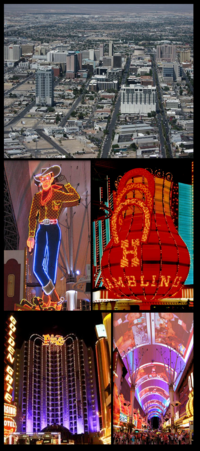
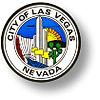
Las Vegas (/lÉaËas ËnveɪɡÉos/) is the most populous city in the U.S. state of Nevada and the county seat of Clark County. Las Vegas is an internationally renowned major resort city for gambling, shopping, and fine dining. The city bills itself as The Entertainment Capital of the World, and is famous for its consolidated casino aehotels and associated entertainment. A growing retirement and family city, Las Vegas is the 31st-most populous city in the United States, with a population at the 2010 census of 583,756. The 2010 population of the Las Vegas metropolitan area was 1,951,269.
Established in 1905, Las Vegas was incorporated as a city in 1911. At the close of the 20th century, Las Vegas was the most populous American city founded in that century (a distinction held by Chicago in the 19th century). The city's tolerance for various forms of adult entertainment earned it the title of Sin City, and this image has made Las Vegas a popular setting for films and television programs. There are numerous outdoor lighting displays on Fremont Street, as well as elsewhere in the city.
Las Vegas often refers to the city plus some areas beyond the city limits, especially the resort areas on and near the Las Vegas Strip, and sometimes the entire Las Vegas Valley. The 4.2 mi (6.8 km) stretch of South Las Vegas Boulevard known as the Strip is mainly in the unincorporated communities of Paradise, Winchester, and Enterprise.
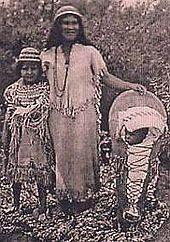
The first reported European visitor to the Las Vegas Valley was Raphael Rivera in 1829. Las Vegas was named by Spaniards in the Antonio Armijo party, who used the water in the area while heading north and west along the Old Spanish Trail from Texas. In the 19th century, areas of the valley contained artesian wells that supported extensive green areas or meadows (vegas in Spanish); hence the name Las Vegas.
On May 3, 1844, while it was still part of Mexico, John C. Fremont led a group of scientists, scouts, and observers for the United States Army Corps of Engineers into the Las Vegas Valley. On May 10, 1855, following annexation by the United States, Brigham Young assigned 30 missionaries of The Church of Jesus Christ of Latter-day Saints led by William Bringhurst to the area to convert the Paiute Indian population to Mormonism. A fort was built near the current downtown area that served as a stopover for travelers along the "Mormon Corridor" between Salt Lake and the briefly thriving colony of saints at San Bernardino, California. Mormons abandoned Las Vegas in 1857, during the Utah War. Las Vegas was established as a railroad town on May 15, 1905, when 110 acres (45 ha) owned by the San Pedro, Los Angeles and Salt Lake Railroad in what is now downtown Las Vegas was auctioned off. Among the railroad's most notable owners and directors were Montana Senator William A. Clark, Utah Senator Thomas Kearns, and R.C. Kerens of St. Louis. Las Vegas was part of Lincoln County until 1908, when it became part of the newly established Clark County. The St. Joan of Arc Catholic Church near 4th and Bridger in downtown was founded in 1910. Las Vegas became an incorporated city on March 16, 1911; Peter Buol was the first mayor.
Las Vegas started as a stopover on the pioneer trails to the west, and became a popular railroad town in the early 20th century. It was a staging point for mines in the surrounding area, especially those around the town of Bullfrog, that shipped goods to the rest of the country. With the proliferation of the railroads, Las Vegas became less important, but the completion of the nearby Hoover Dam in 1935 resulted in growth in the number of residents and increased tourism. The dam, located 30 mi (48 km) southeast of the city, formed Lake Mead, the largest man-made lake and reservoir in the US. Today, tours are offered into lesser-known parts of the dam. The legalization of gambling in 1931 led to the advent of the casino hotels for which Las Vegas is famous. Major development occurred in the 1940s, "due almost entirely" to the influx of scientists and staff from the Manhattan Project, an atomic bomb research project of World War II. Atomic test watching parties were sometimes thrown. American organized crime figures such as Benjamin "Bugsy" Siegel and Meyer Lansky managed or funded most of the original large casinos. The rapid growth of Las Vegas is credited with dooming Galveston, Texas; Hot Springs, Arkansas; and other major gaming centers in the 1950s.
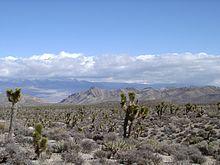
Las Vegas is situated within Clark County in an arid basin on the desert floor, surrounded by dry mountains. The Spring Mountains lie to the west. Much of the landscape is rocky and dusty; the environment is dominated by desert vegetation and some wildlife, and the area is subject to torrential flash floods. The elevation is around 2,030 ft (620 m) above sea level. According to the United States Census Bureau, the city has a total area of 135.86 sq mi (351.9 km2), of which 131.81 sq mi (341.4 km2) is land and 0.05 sq mi (0.13 km2) (0.03%) is water.
Within the city there are many lawns, trees, and other greenery. Due to water resource issues, there is now a movement to encourage xeriscapes. Another part of the water conservation efforts include scheduled watering groups for watering residential landscaping. A U.S. Environmental Protection Agency grant in 2008 funded a program that analyzed and forecast growth and environmental impacts through the year 2019.
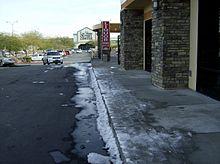
Las Vegas' climate is a subtropical desert climate (Koppen climate classification BWh), typical of the Mojave Desert in which it lies. The city enjoys abundant sunshine year-round: it has an average of about 300 sunny days per year with more than 3,800 hours of sunshine.
The summer months of June through September are very hot and mostly dry, with average daytime highs of 94 to 104 °F (34 to 40 °C) and night-time lows of 69 ae78 °F (21 ae26 °C). There are an average of 133 days per year above 90 °F (32 °C), and 72 days above 100 °F (38 °C), with most of the days in July and August exceeding that benchmark. Humidity is very low, often under 10%.
Las Vegas' winters are of short duration and the season is generally mild, with daytime highs near 60 °F (16 °C) and nighttime lows around 40 °F (4 °C). The mountains surrounding Las Vegas accumulate snow during the winter but snow is rare in the Las Vegas Valley itself. Temperatures can sometimes drop to freezing 32 °F (0 °C) but winter nighttime temperatures will rarely dip below 30 °F ( na1 °C).
Annual precipitation in Las Vegas is roughly 4.5 in (110 mm), which on average occurs on 29 days per year. Most of the precipitation falls in the winter, but the wettest month (March) has on average only 3.6 days of precipitation.
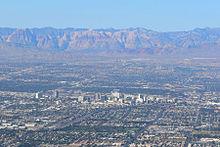
According to the 2010 Census, the racial composition of Las Vegas was as follows:
Source:
The city's most populous ethnic group, non-Hispanic White, has declined from 72.1% in 1990 to 47.9% in 2010.
As of the census of 2010, there were 583,756 people, 211,689 households, and 117,538 families residing in the city. The population density was 4,222.5 /sq mi (1,630.3 /km2). There are 190,724 housing units at an average density of 1,683.3 /sq mi (649.9 /km2).
As of 2006, there were 176,750 households, out of which 31.9% had children under the age of 18 living with them, 48.3% were married couples living together, 12.2% had a female householder with no husband present, and 33.5% were non-families. 25.0% of all households were made up of individuals and 7.5% had someone living alone who was 65 years of age or older. The average household size was 2.66 and the average family size was 3.20.
In the city the population was spread out with 25.9% under the age of 18, 8.8% from 18 to 24, 32.0% from 25 to 44, 21.7% from 45 to 64, and 11.6% who were 65 years of age or older. The median age was 34 years. For every 100 females there were 103.3 males. For every 100 females age 18 and over, there were 102.5 males.
The median income for a household in the city was $53,000 and the median income for a family was $58,465. Males had a median income of $35,511 versus $27,554 for females. The per capita income for the city was $22,060. About 6.6% of families and 8.9% of the population were below the poverty line, including 5.4% of those under age 18 and 6.3% of those age 65 or over.
Las Vegas has one of the highest suicide and divorce rates of the U.S. A study that found Las Vegas residents are 40% less likely to commit suicide if they leave Las Vegas and visitors are more than twice as likely to commit suicide there as elsewhere was published in the Las Vegas Sun newspaper in 2008. The city's high divorce rate is not wholly due to Las Vegans themselves getting divorced. Since divorce is easier in Nevada than most other states, many people come from across the country for the easier process.
For similar reasons, Las Vegas has one of the highest marriage rates of U.S. cities, with many licenses issued to people from outside the area (see Las Vegas weddings).
The primary drivers of the Las Vegas economy are tourism, gaming, and conventions, which in turn feed the retail and restaurant industries.
The major attractions in Las Vegas are the casinos and the hotels. Most of the hotel casinos are in the city's downtown area, which has been the focal point of the city's gaming industry since its early days.
Most major casinos are downtown on the Fremont Street Experience, The Stratosphere being the major exception. Fremont East, adjacent to the Fremont Street Experience, was granted variances to allow bars to be closer together, similar to the Gaslamp Quarter of San Diego, the goal being to attract a different demographic than the strip attracts.
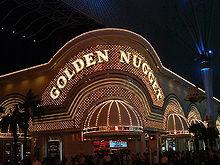
Las Vegas got its start with casinos in 1931 with the opening of the Northern Club (now the La Bayou). The most notable of the early casinos may have been Binion's Horseshoe (now Binion's Gambling Hall and Hotel) while it was run by Benny Binion. Boyd Gaming has a major presence downtown operating the California Hotel and Casino, Fremont Hotel and Casino and the Main Street Casino. The Golden Gate Hotel and Casino is the oldest hotel in the Fremont Street Experience. The Golden Nugget is the largest hotel and casino in the city. The Plaza Hotel & Casino on Main Street was the railway station until Amtrak discontinued service. Other casinos include the El Cortez, The D, Four Queens, Gold Spike Hotel and Casino and the Las Vegas Club.
The gambling and entertainment industry in Las Vegas is mostly focused in the Las Vegas Strip. The Strip is not actually located in city limits, but instead in the surrounding unincorporated communities of Paradise and Winchester. The largest and most notable casinos and buildings are located there.
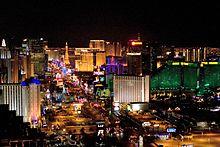
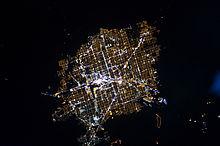
When The Mirage opened in 1989, it started a trend of major resort development of the southern portion of the Las Vegas Strip outside of the city. This resulted in a drop in tourism in the downtown area, but many recent projects and condominium construction have increased the number of visitors to downtown.
An effort has been made by city officials to diversify the economy by attracting light manufacturing, banking, and other commercial interests. The lack of state individual and corporate income tax and very simple incorporation requirements have fostered the success of this effort.
With the Strip expansion in the 1990s, Downtown Las Vegas (which has maintained an old Las Vegas feel) began to suffer. The city made an effort to turn around the fortunes of downtown. The city successfully lured the Internal Revenue Service operations from western side of the city to a new downtown area building that opened in April 2005. The IRS move was expected to create a greater demand for additional businesses in the area, especially in the daytime hours. The Fremont Street Experience (FSE) was built in an effort to draw tourists back to the area, and has been popular. Since the recession began in 2008, many of these shops have closed. The multi-level Neonopolis closed their 11 theaters and nearly all retail stores. Many high-rise condo projects have been under construction, but one of the highest profile buildings, The Streamline Towers, went into bankruptcy.
The city purchased 61 acres (25 ha) of property from the Union Pacific Railroad in 1995 with the goal of creating something to draw more people to the downtown area. In 2004 Las Vegas Mayor Oscar Goodman announced plans for Symphony Park, which will include residential and office high-rises, the Lou Ruvo Brain Institute, an academic medical center, The Smith Center for the Performing Arts, and a new City Hall. After failed negotiations with The Related Co. on the development of Union Park in October 2005, San Diego-based Newland Communities was chosen by the city as the new development firm. The Newland contract calls for Dan Van Epp, Newland's regional vice president and former president of The Howard Hughes Corporation, to oversee his company's work on Symphony Park. The Lou Ruvo Brain Institute was completed in 2009.
In 2004 the city partnered with Cheetah Wireless Technologies and MeshNetwork to pilot a wide-area mobile broadband system. The pilot system is installed downtown, around the Fremont Street Experience. On a lot adjacent to the city's 61 acre site, the World Market Center opened in 2005. It was intended as a preeminent furniture wholesale showroom and marketplace to compete with the current furniture market capital of High Point, North Carolina.
On October 23, 2006, plans were unveiled to build a World Jewelry Center in Symphony Park. Similar to the World Market Center, the WJC will be a one stop shop for jewelry trade shows from around the world. The project proposes a 57-story, 815 ft (248 m) office tower. As of 2009 the project was still on hold.
Las Vegas decided to build a new city hall in the late 2000s. This had several consequences. One is that the Las Vegas Metropolitan Police Department, which shared city hall, would have to find a new location. A second is that the old building would be vacated, with a potential negative impact on the downtown area. The police department elected to build a headquarters building in another part of the city and consolidate most of its operations in one place. This increased the department's presence within the city since it would be moving in employees not presently working in the city. The second problem was addressed when the city and Zappos reached an agreement for Zappos to move its headquarters into the old city hall.
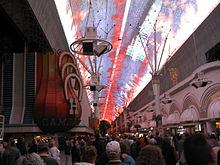
The city is home to several museums including the Neon Museum home to many of the historical signs from the valley, The Las Vegas Museum of Organized Crime and Law Enforcement, the Las Vegas Natural History Museum, Lied Discovery Children's Museum National Atomic Testing Museum, and the Old Las Vegas Mormon State Historic Park.
On the first Friday of each month, the "First Friday" celebration is held, which exhibits the works of local artists and musicians in a section of the city's Downtown region called the "Arts District".
The Thursday prior to First Friday is known in the 18b Arts District as "Preview Thursday". This evening event highlights new gallery exhibitions just opening throughout the district.
The Southern Nevada Zoological-Botanical Park, also known as the Las Vegas Zoo, exhibits over 150 species of animals and plants.
The $485 million Smith Center for the Performing Arts is located downtown in Symphony Park. The center hosts Broadway shows and other major touring attractions as well as orchestra, opera, and dance performances.
The city hosts annual events like the Helldorado Days.
Las Vegas does not have major-league sports, although the metropolitan population is as large or larger than many cities that have them. The two main reasons are concern about legal sports betting and competition for the entertainment dollar. The only minor league sports team that plays in the City of Las Vegas is baseball's Las Vegas 51s of the Pacific Coast League, the AAA farm club of the New York Mets. The United Football League's Las Vegas Locomotives play in nearby Whitney, Nevada.
Las Vegas has dozens of parks, including Las Vegas Springs Preserve, a recreational and educational facility, and Floyd Lamb Park at Tule Springs. The city operates 4 golf courses (Angel Park Golf Club, Desert Pines Golf Course, Durango Hills Golf Club and the Las Vegas Municipal Golf Course), 5 dog parks, 9 community centers, 8 senior centers and 20 sports facilities including 9 skate parks and 6 swimming pools.
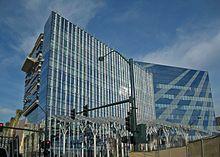
The City of Las Vegas government operates as a council aemanager government. The Mayor sits as a Council member-at-large and presides over all of the City Council meetings. In the event that the Mayor cannot preside over a City Council meeting, the Mayor Pro-Tem is the presiding officer of the meeting until such time as the Mayor returns to his seat. The City Manager is responsible for the administration and the day-to-day operation of all of the municipal services and city departments. The City Manager maintains intergovernmental relationships with federal, state, county, and other local governments.
Much of the Las Vegas metropolitan area is split into neighboring incorporated cities or unincorporated communities. Approximately 700,000 people live in unincorporated areas governed by Clark County, and another 465,000 live in incorporated cities such as North Las Vegas, Henderson, and Boulder City. Las Vegas and nearly all of the surrounding metropolitan area share a police department, the Las Vegas Metropolitan Police Department, which was formed after a 1973 merger of the Las Vegas Police Department and the Clark County Sheriff's Department. North Las Vegas, Henderson, Boulder City, and some colleges have their own police departments.
A Paiute Indian reservation occupies about 1 acre (0.40 ha) in the downtown area.
Las Vegas, as the county seat and home to the Lloyd D. George Federal District Courthouse, draws numerous legal service industries providing bail, marriage, divorce, tax, incorporation, and other legal services.
Primary and secondary public education is provided by the Clark County School District, which is the fifth most populous school district in the nation (projected enrollment for the 2007 ae2008 school year was 314,000 students in grades K ae12).
The College of Southern Nevada (the third largest community college in the United States by enrollment) is the main higher education facility in the city. Other institutions include the University of Nevada School of Medicine, with a campus in the city, and the for-profit private school Le Cordon Bleu College of Culinary Arts. Many educational opportunities exist around the city. These include University of Nevada, Las Vegas and Nevada State College run by the Nevada System of Higher Education, Desert Research Institute, The International Academy of Design & Technology Las Vegas, Touro University Nevada and the University of Southern Nevada.
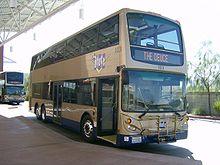
RTC Transit is a public transportation system providing bus service throughout Las Vegas, Henderson, North Las Vegas, and other suburban areas of the valley. Inter-city bus service to Las Vegas is provided by Greyhound, many charter services, including Green Tortoise, and several Chinatown bus lines. Amtrak California operates Deluxe Express Thruway Motorcoach dedicated service between the City and its passenger rail station in Bakersfield, California.
A bus rapid transit link in Las Vegas called the Strip & Downtown Express (previously ACE Gold Line) with limited stops and frequent service was launched in March 2010, and connects Downtown Las Vegas, the Strip, the Las Vegas Convention Center, and Town Square.
With some exceptions, including Las Vegas Boulevard, Boulder Highway (SR 582), and Rancho Drive (SR 599), the majority of surface streets in Las Vegas are laid out in a grid along Public Land Survey System section lines. Many are maintained by the Nevada Department of Transportation as state highways. The street numbering system is divided by the following streets:
Interstates 15, 515, and US 95 lead out of the city in four directions. Two major freeways ae Interstate 15 and Interstate 515/U.S. Route 95 ae cross in downtown Las Vegas. I-15 connects Las Vegas to Los Angeles, and heads northeast to and beyond Salt Lake City, Utah. I-515 goes southeast to Henderson, beyond which US 93 continues over the Mike O'Callaghan ae Pat Tillman Memorial Bridge towards Phoenix, Arizona. US 95 connects the city to northwestern Nevada, including Carson City and Reno. US 93 splits from I-15 northeast of Las Vegas and goes north through the eastern part of the state, serving Ely and Wells. US 95 heads south from US 93 near Henderson through far eastern California. A partial beltway has been built, consisting of Interstate 215 on the south and Clark County 215 on the west and north. Other radial routes include Blue Diamond Road (SR 160) to Pahrump and Lake Mead Boulevard (SR 147) to Lake Mead.
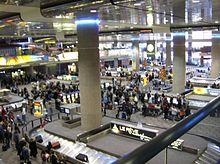
McCarran International Airport handles international and domestic flights into the Las Vegas Valley. The airport also serves private aircraft and freight/cargo flights. Most general aviation traffic uses the smaller North Las Vegas Airport and Henderson Executive Airport.
The Union Pacific Railroad is the only Class I railroad to provide rail freight service to the city. Until 1997, the Amtrak Desert Wind train service ran through Las Vegas using the Union Pacific Railroad tracks. Amtrak service to Las Vegas goes to Needles, California and continues on Amtrak's Thruway Motorcoach bus service. Plans to restore Los Angeles to Las Vegas Amtrak service using a Talgo train were discussed in the late 1990s, but the plan was not implemented. The Las Vegas Amtrak station was located in the Plaza Hotel; it held the distinction of being the only train station in the US that was located in a casino.
A 2011 study by Walk Score ranked Las Vegas 25th most walkable of fifty largest U.S. cities.
Las Vegas has several sister cities, as designated by Sister Cities International:

Word Count: 4630





